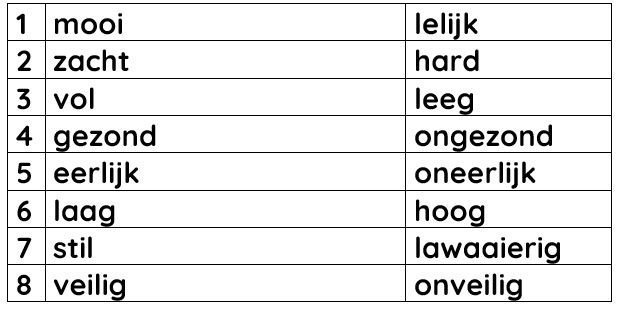
Describing something


We have placed this section before the next section. This next section is about shopping and shopping always involves a number of typical terms such as: less, more, enough. Of course, sentences such as: this is too expensive, that is cheap and where can I pay, also occur. But when choosing, we always feel the need to be able to describe more. This section shows how we can say more about "a thing" and more about a verb.

Adjectives are words that describe nouns. They give us more information about the objects, people, places, or things we talk about. You can think of adjectives as little helpers that add color, size, shape, or other qualities to nouns.
Let's use a simple example with a car. Look at the picture
First sentence: the car is red.
In this sentence, "red" describes the color of the car. The adjective "red" comes after the verb "is" and gives us more details about the car.
Second sentence: the red car.
Here, "red" is directly before "car," describing the car’s color right away. This shows the adjective "red" working right next to the noun "car" to tell us what kind of car it is.
In both cases, the adjective "red" provides information about the noun "car," helping us picture a red car instead of just any car.

1. the house is big / the big house
2. the boat is small / the small boat
3. the dress is beautiful / the beautiful dress
4. the pants are ugly / the ugly pants
5. the girl is nice / the nice girl
6. the boy is bad / the bad boy
7. the water is warm / the warm water
8. the water is cold / the cold water
For an introduction about adverbs the following sentence is used:

Image Description
Adverbs are words that describe how something is done or something feels. They can add information to verbs, or even whole sentences. They often tell us more about when, where, or how well something happens.
Let's use a simple example and look at the example above:
Sentence: Driving (in) this car is super.
In this sentence, "super" is the adverb. It describes the action of driving the car. It tells us that driving this car is not just good; it's really great! "Super" helps explain that driving the car is a great experience.
Usually with each adverb there is also an opposite. For instance:

Image Description
In the sentence "The man is happy," "happy" is actually an adjective, not an adverb. Adjectives describe nouns (or pronouns), while adverbs modify verbs, adjectives, or other adverbs.
Example (1): "The happy woman." (describing the woman, therefore describing a noun))
Example (2): "She feels happy." (describing how she feels, therefore describing a verb).
In each language we see how the word that describes something always has an opposite.
Here are a few tables. Of course you have to learn these words!

1. good/bad
2. happy/sad
3. big/little or small
4. quick/slow
5. hot/cold
6. young/old
7. leight/heavy
8. easy/difficult

1. rich/poor
2. strong/weak
3. kind/unkind
4. clean/dirty
5. clever/dumb
6. cheap/expensive
7. early/late
8. broad/small

1. beautiful/ugly
2. soft/hard
3. full/empty
4. healthy/unhealthy
5. honest/unfair
6. low/high
7. quiet/noisy
8. safe/unsafe
Here are the rules in simple English:
When to add -e to an adjective:
If the adjective comes before a noun with "de" or "het" (the), add -e to the adjective.
Examples: "de zwarte auto" (the black car), "het grote huis" (the big house).
When not to add -e to an adjective:
If the adjective comes before a singular noun with "een" (a) and the noun is a "het" word, don't add -e.
Examples: "een zwart huis" (a black house), "een groot boek" (a big book).
If the adjective comes after the noun, don't add -e.
Examples: "de auto is zwart" (the car is black), "het huis is groot" (the house is big).
So, "deze auto is zwart" (this car is black) uses "zwart" without -e because it comes after the noun. "deze zwarte auto" (this black car) uses "zwarte" with -e because it comes before the noun with "de".
Here are more examples:

Image Description
test

1. the house is big / the big house
2. the boat is small / the small boat
3. the dress is beautiful / the beautiful dress
4. the pants are ugly / the ugly pants

5. the girl is nice / the nice girl
6. the boy is bad / the bad boy
7. the water is warm / the warm water
8. the water is cold / the cold water
<<<

1. good/bad
2. happy/sad
3. big/little or small
4. quick/slow
5. hot/cold
6. young/old
7. leight/heavy
8. easy/difficult
<<<

1. rich/poor
2. strong/weak
3. kind/unkind
4. clean/dirty
5. clever/dumb
6. cheap/expensive
7. early/late
8. broad/small
<<<

1. beautiful/ugly
2. soft/hard
3. full/empty
4. healthy/unhealthy
5. honest/unfair
6. low/high
7. quit/noisy
8. safe/unsafe
The site was designed with Mobirise